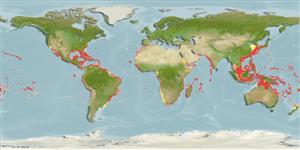Elasmobranchii (tubarões e raias) (sharks and rays) >
Carcharhiniformes (Ground sharks) >
Carcharhinidae (Requiem sharks)
Etymology: Carcharhinus: Greek, karcharos = sharpen + Greek, rhinos = nose (Ref. 45335).
Ambiente / Clima / Intervalo
Ecologia
; marinhas associadas(os) a recifes; intervalo de profundidade 1 - 286 m (Ref. 58302), usually 30 - 180 m (Ref. 37816). Tropical, preferred ?; 36°N - 41°S, 180°W - 180°E (Ref. 55181)
Circumtropical with a preference for waters around oceanic islands. Eastern Atlantic: including St. Paul's Rocks (Refs. 13121, 52289). Western Indian Ocean: including Walter's Shoal, south of Madagascar. Western Pacific: including Middleton and Elizabeth Reefs. Eastern Pacific: Galápagos (Ref. 58896).
Length at first maturity / Tamanho / Peso / Idade
Maturity: Lm ?, range 215 - 245 cm
Max length : 370 cm TL macho/indeterminado; (Ref. 1602); common length : 300 cm TL macho/indeterminado; (Ref. 9253); Peso máx. publicado: 85.5 kg (Ref. 40637); Idade máx. registada: 24 anos (Ref. 31395)
Espinhos dorsais (total): 0; Raios dorsais (total): 0; Espinhos anais 0; Raios anais : 0. Low inter-dorsal ridge present (Ref.9997). Dark grey above, light below, fins plain or with slightly dusky tips (Ref. 9997).
A common but habitat-limited tropical shark found close inshore to well as offshore near or on insular or continental shelves (Ref. 244). Prefers clear water with coral and rocky bottoms (Ref. 244). Although a coastal pelagic species, it is capable of crossing considerable distances of open ocean between islands (at least 50 km) (Ref. 244). Juveniles restricted to shallower water, in 25 m or less (Ref. 244; 37816). Found in superficial aggregations (Ref. 244). Tends to feed near the bottom but may take bait from the surface (Ref. 5485). Feeds mainly on bottom fishes, also squid and octopi (Ref. 244). In the Galapagos Is. it preys on sea lions and marine iguanas (Ref. 28023). Aggressive and dangerous to people (Ref. 9997). Viviparous (Ref. 50449). 6 to 16 young of 57 to 80 cm are born per litter (Ref. 1602).
Viviparous, with a yolk sac placenta (Ref. 244). 6 to 16 young born at 60-80 cm (Ref. 26346). Distinct pairing with embrace (Ref. 205).
Compagno, L.J.V., 1984. FAO Species Catalogue. Vol. 4. Sharks of the world. An annotated and illustrated catalogue of shark species known to date. Part 2 - Carcharhiniformes. FAO Fish. Synop. 125(4/2):251-655. Rome: FAO. (Ref. 244)
Status na Lista Vermelha da IUCN (Ref. 115185)
CITES (Ref. 94142)
Not Evaluated
Perigo para os humanos
Traumatogenic (Ref. 4690)
Uso pelos humanos
Pescarias: pouco comercial
Mais informação
ReferênciasAquaculturaPerfil para aquaculturaEstirpesGenéticaFrequência alélicaHereditariedadeDoençasProcessamentoMass conversion
ColaboradoresFotosStamps, CoinsSonsCiguateraVelocidadeTipo de nataçãoÁrea branquialOtólitosCérebrosVisão
Ferramentas
Relatórios especiais
Baixar XML
Fontes da internet
